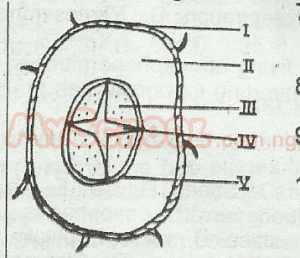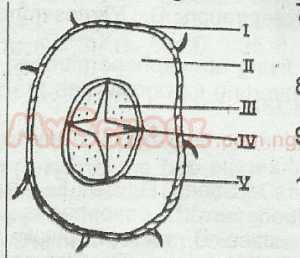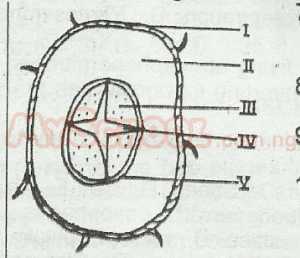Year :
1998
Title :
Biology
Exam :
WASSCE/WAEC MAY/JUNE
Paper 1 | Objectives
1 - 10 of 60 Questions
| # | Question | Ans |
|---|---|---|
| 1. |
Which of the following organisms exhibits both plant and animal characteristics? A. Amoeba B. Spirogyra C. Mucor D. Euglena E. Moss |
D |
| 2. |
Which of the following is not an organ? A. Hair B. Tongue C. Rhizome D. Corn E. Heart |
A |
| 3. |
One major difference between osmosis and diffusion is that diffusion A. does not need a semipermeable membrane B. does not take place in living tissues C. takes place only in a liquid medium D. takes place only in a gaseous medium E. cannot be demonstrated experimentally |
A |
| 4. |
Which of the following is a difference between mitosis and meiosis? A. Alignment of chromosomes along the equitorial plane B. Replication of the chromosomes and the cell organelles C. Pairing of homologous chromosomes D. Formation of spindle fibers E. Thickening of chromatin threads at prophase |
C |
| 5. |
Which of the following can be used for vegetative propagation? A. Ginger stem B. Yam leaf C. Plantain roots D. Sweet potato tuber E. Carrot root |
A |
| 6. |
Which of the following is a method of artificial vegetative propagation? A. Creeping stem B. Layering C. Corm D. Rhizome E. Bulbil |
B |
| 7. |
 The above diagram represents a A. longitudinal section of a stem B. longitudinal section of a root C. cross section of a root D. transverse section of stem E. longitudinal section of a leaf |
C |
| 8. |
 The part labelled II in the diagram is the A. epidermis B. cortex C. phloem D. xylem E. cuticle |
B |
| 9. |
 The part labelled IV in the diagram is the A. phloem B. pericycle C. cortex D. xylem E. epidermis |
D |
| 10. |
Which of the following is not a function of the blood? A. Maintenance of body temperature B. Formation of clot C. Distribution of bile D. Transportation of excretory materials. E. Distribution of hormones |
C |
| 1. |
Which of the following organisms exhibits both plant and animal characteristics? A. Amoeba B. Spirogyra C. Mucor D. Euglena E. Moss |
D |
| 2. |
Which of the following is not an organ? A. Hair B. Tongue C. Rhizome D. Corn E. Heart |
A |
| 3. |
One major difference between osmosis and diffusion is that diffusion A. does not need a semipermeable membrane B. does not take place in living tissues C. takes place only in a liquid medium D. takes place only in a gaseous medium E. cannot be demonstrated experimentally |
A |
| 4. |
Which of the following is a difference between mitosis and meiosis? A. Alignment of chromosomes along the equitorial plane B. Replication of the chromosomes and the cell organelles C. Pairing of homologous chromosomes D. Formation of spindle fibers E. Thickening of chromatin threads at prophase |
C |
| 5. |
Which of the following can be used for vegetative propagation? A. Ginger stem B. Yam leaf C. Plantain roots D. Sweet potato tuber E. Carrot root |
A |
| 6. |
Which of the following is a method of artificial vegetative propagation? A. Creeping stem B. Layering C. Corm D. Rhizome E. Bulbil |
B |
| 7. |
 The above diagram represents a A. longitudinal section of a stem B. longitudinal section of a root C. cross section of a root D. transverse section of stem E. longitudinal section of a leaf |
C |
| 8. |
 The part labelled II in the diagram is the A. epidermis B. cortex C. phloem D. xylem E. cuticle |
B |
| 9. |
 The part labelled IV in the diagram is the A. phloem B. pericycle C. cortex D. xylem E. epidermis |
D |
| 10. |
Which of the following is not a function of the blood? A. Maintenance of body temperature B. Formation of clot C. Distribution of bile D. Transportation of excretory materials. E. Distribution of hormones |
C |